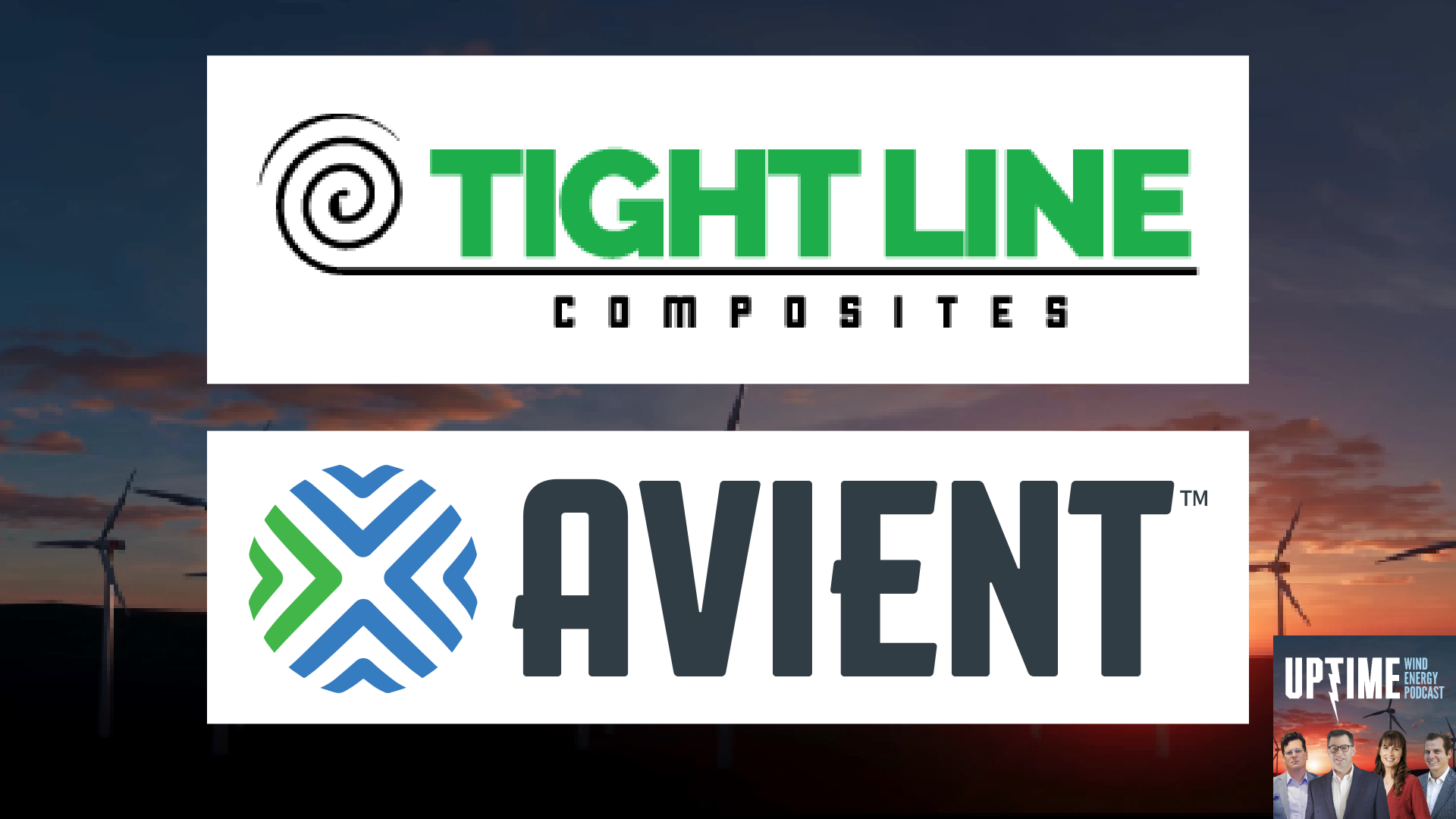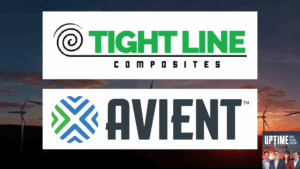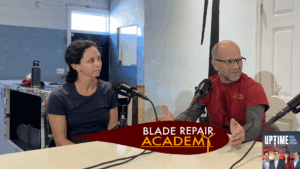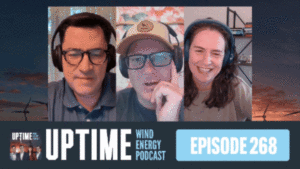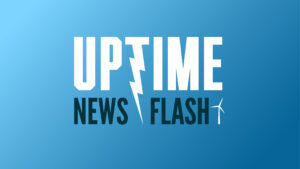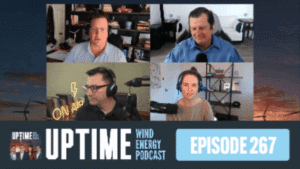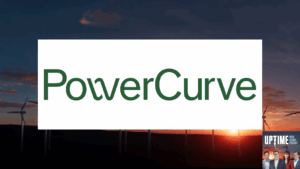Podcast: Play in new window | Download
Avient and Tight Line Composites have developed a carbon pultrusion technology without the need for peel ply. This method improves bond strength by 8%, cuts waste, reduces labor costs, and simplifies manufacturing.
Sign up now for Uptime Tech News, our weekly email update on all things wind technology. This episode is sponsored by Weather Guard Lightning Tech. Learn more about Weather Guard’s StrikeTape Wind Turbine LPS retrofit. Follow the show on Facebook, YouTube, Twitter, Linkedin and visit Weather Guard on the web. And subscribe to Rosemary Barnes’ YouTube channel here. Have a question we can answer on the show? Email us!
Welcome to Uptime Spotlight, shining Light on Wind. Energy’s brightest innovators. This is the progress powering tomorrow.
Allen Hall: Andrew and Brad, welcome to the show. Thanks for having us. Thank you. Well, we’re gonna start off by talking about carbon protrusions, because that’s the focus of your technology, title IX composites, and there’s been some recent advancements that are really fascinating, but I, I kind of wanna go back a minute because carbon pull protrusions are the future, even though we’re still making some fiberglass blades that’ll have a limited lifespan.
We’re gonna be moving to carbon protrusions because the strength and the weight. And the cost, simplicity of it, uh, just makes carbon protrusions the future. And Tightline Composites has been key in that mold of making these, uh, carbon planks and getting ’em out to industry. I. But one of the big problems with any sort of carbon plank product is it [00:01:00] usually has a peel ply.
And Andrew, you wanna talk about what that peel ply does and why it’s used and why we need it.
Andrew Davis: You really need that surface energy created by removing the peel ply to, to get an effective bond as you’re building your spark cap. And so for years, this has just been considered a necessary evil. Uh, in terms of creating, creating that effective bond.
And, and that’s, that’s the world we’ve lived in for the last 10 years.
Allen Hall: And a peel ply for those who are not deep into the composite industry. Peel, ply is a removable. Ply a fabric that’s that’s applied over the carbon on the outside and it’s kind of thicker and it has, uh, this kind of rough and surface.
So when you build the protrusion, you got these two layers of this peel ply on either side, and it travels with the product. So as, uh, tight line sends out product, these, these peel plys go with it. [00:02:00] And ideally when they get to the factory, the, the people on the floor. Pull this peel play off and it’s not fun to peel off one and two, it’s kind of invisible.
So you can forget that it’s there and install it in ablaze. And Joel, you have seen that in the field. You’ve seen protrusions where they have the ply still attached.
Joel Saxum: Yeah, it’s, it’s like, um, Alan, we saw one of the other day too, where it was like there was still a coating on a down conductor, right? So like, if you.
If you try to embed this product, the, the idea behind peel and the peel ply is you peel the peel ply, and now you have a prepped surface that can be chemically and mechanically bonded to easier or in, in, in, in a much better way, as designed. So if you forget to pull that off, now you have a structural element inside the PLA or inside of whatever you may be building in composites.
That doesn’t have the ability to bond properly to that protrusion, to that carbon plank or to that glass plank. Uh, and if that’s the case, you lose, I can’t [00:03:00] put a number to it. Right. But you lose an immense
Andrew Davis: amount of structural strength. And Joel, just to underline your point, we’ve heard from customers who will remain nameless that it is, it, it happens that, that this will get caught on scan.
Uh, when the blade is completely done, and then the entire blade has to be scrapped. There’s no, there’s no fixing it.
Allen Hall: Yeah. That, that, that gets expensive. Real quick, you’re talking about a hundred thousand dollars blades for onshore. Forget about offshore for a minute. An offshore blade, multi times, is that three or four?
Uh, so the, the, the, the engineering is right. The protrusion is the right answer and carbon is the right answer for blades, but it’s really comes down to getting. The peel ply and what, what do you wanna deal with that? ’cause the other part of the peel ply is you just create this waste cycle that peel ply gets just tossed into the garbage.
It’s not a recyclable thing, it’s one use and it’s done. So the, in the carbon protrusion world, if we can remove that peel ply, that is huge, [00:04:00]gigantic. However, it is been really hard to do that because there hasn’t been any technology to remove it, and we’ve been using it. Forever in aerospace and wind, and that’s where Brad comes in.
And Brad’s company has developed a way to eliminate the Peel ply, which is a huge cost savings and a labor savings and a, you know, a downstream savings. Brad, you wanna under describe the, what you’re bringing to Tightline and, and how this technology works.
Brad Schmidt: So we do protrusion within Aviant as well, and we’ve developed this over the last four or five years and have been using it internally.
For our own glass profiles, um, in, in various markets, including wind. Um, but essentially, yes, have eliminated the need for these glass protrusions to, uh, you know, require peel, ply or alternatively sanding or some sort of grinding process prior to, um, adhesion. So the, it is, it is actually in the chemistry of the [00:05:00] resin system.
It’s not a surface treatment and it is throughout the part. Um, so if you cut the, you know, through apart that same adhesion, uh, you know, or bond strength will be realized throughout the, the Matrix. It’s not just on the surface. Um, so again, we’ve been using this in-house for a number of years. We’ve known the Tightline team for some time, and we approach them.
Late last year, uh, about six months ago, let’s say. And um, obviously there was a lot of interest in tightline. There was a lot of skepticism at first in that, uh, this would even work, but they were willing to give it a try. So we sent them a small batch of resin with this, call it an additive in it. They ran some trials and then we tested in our lab, uh, did the lap shear testing on a traditional, uh, carbon plank with peel ply.
And then a protruded plank without peel ply. With this new chemistry, we saw on average about an 8% [00:06:00] improved improvement in bond strength in the, with the chemistry versus the traditional peel ply, and a much tighter standard deviation in that bond strength.
Joel Saxum: So let me, let me, let me get this straight. So you not only have removed waste, removed the cost of those, the procuring of the PO ply materials.
Increase the ability for manufacturing processes to be correct and at the same time have improved the strength of the bond. That’s right.
Brad Schmidt: Yeah. I mean, um, and seems too good to be true, right? And we’re trying to find out where this doesn’t work, but, but we haven’t, yeah, we have not been able to poke holes in it yet.
Um, and then on the mechanical property side, uh, they’ve actually seen a slight improvement. Um, and in theory now without Peel ply, you can add a bit more carbon. Where the PO ply would’ve previously taken up space in the dye. Right. Um, and the additive is, is at a very low concentration, so it’s had no detrimental effects on any of the mechanical.
Properties.
Allen Hall: That is amazing. So [00:07:00] obviously the first question that any composite engineer is gonna ask is, well, it, it’s a resin change, right? So I gotta requalify the material. But it’s not really a resin change are you’re still using the same resin system. Correct. So it is, it is it. Is it a magic powder or a chemical treatment to the existing resin system?
And I, you know, composite engineers are always weary of change, right? If they have something they, that they know, they tested, it’s been through all the processes and all the approvals, and now you wanna make a change. So the, the always the answer is no, which is crazy because if, if you’re improving it and you can show it and you have the data to back it up, and Ian’s gonna do that.
You can use the same resin system, just add a little bit of technology to it to remove peel ply, and, and that’s the approach. So it’s not a, um, it’s not a wholesale change in the resin system or the strength of the system. It is in the, the surface energy piece. That technology is pretty transferrable, right?
I mean, [00:08:00] pretty much anybody with an existing resin system can use this technology, right?
Brad Schmidt: Yeah, absolutely. So we developed this originally in a vinyl Lester system. We’ve since proven it out in, um, developed it in polyester as well as epoxy, which is used in the, uh, the carbon poulation process for the planks.
Um. So it’s absolutely transferrable. Like I said, it’s at a very low concentration, so it is the same base resin system just with our, uh, you know, magic powder as you referred to. And I think
Joel Saxum: I ask you a, a, a question that’s a little bit. Um, so we were talking about carbon protrusions and other kind of protrusion, cla protrusions and different vinyl es the things that you’ve done in the pultrusion space.
This is fantastic. However, let me ask you another question. If this is mixed with a resin system, where else can it be used? Can it be used in repairs? Could it be used in, I know like one of the things that happens in wind right now, Alan and I talked too about it regularly, is these root bushing pullout things and there’s a couple companies working on Gulf wind [00:09:00] technology.
We foresee there’s some people working on fixes for these. Could this be added to whatever resin systems they’re using and increase? And I’m thinking about that 8% strength in bond number. Can that be used as a repair methodology too? Yeah, without a doubt.
Brad Schmidt: Um, and actually I say 8% that’s in the epoxy system.
In our vinyl ester and polyester, we see upwards of 10 to almost 15% in a lot of cases. So yes, for repair, and I think where it gets more exciting is, um, in blade infusion. Uh, and, and there’s, we are working through some infusion trials right now. We’ve only applied this to protrusion thus far, but in theory, there’s no reason this also doesn’t work in an infusion process.
Um, and not just for wind, I think about the marine industry too, where you’re infusing a boat haul and then going back and standing the entire inside of a hu before any adhesion. So, uh, yeah, we’re really excited about the potential here. Um, this is a trade secret, so we’ve been very selective with, you know, who we partner with and we’ve [00:10:00] known the tight line team for a number of years, and there’s a high degree of trust there.
And, um, but, but yes, to answer your question, repair. Infusion, you know, we, we wanna eliminate any secondary prep, peel, ply, grinding, et cetera, prior to, uh, bonding.
Allen Hall: And Andrew, that’s gonna be great for Tightline. If you have an improved adhesion system with less stuff and less waste downstream, that’s a major advantage for Tightline.
Andrew Davis: It’s amazing. And, and I, I, you know, I don’t wanna say that we were skeptical, but, uh, the, the results were surprising and amazing in a, in a very happy way. And, um. I, you know, I, I think you hit the nail on the head, Joel, with the, you know, waste is obviously a big thing from a cost standpoint, from an environmental footprint standpoint.
There’s obviously labor cost improvements here. When you think about what one of these factories looks like, the, the peel ply is largely removed and automated process by a [00:11:00] machine that might at the same time also be chaing or whatever. Um. That’s not a hundred percent foolproof. And so you’ll have bits of peel ply that, that get stuck in there.
The machine will get gummed up and the peel ply will go everywhere. Those machines need to be maintained. You know, there’s, when you sort of add it up, there’s rework that’s caused by problems that are caused by peel, ply, and, and, and in extreme cases, scrap, um, you know, all that adds up to labor and, um. I and, and quality, right?
When you, when you sort of think about the scrap things, um, environmental e eventually you won’t need to. We, we talked to a customer who said, man, we just bought a bunch of machines to fuel ply. Like, why couldn’t you have told me this last month? Right? Um, but you know, you won’t have to buy those machines.
Um. I, you know, there’s some little subtle things like the nylon six six, that’s [00:12:00] the material that Peel ply is made out of. Um, there’s a couple things about that. It, it’s cut for each profile. There’s a fair bit of waste on our end of, oh, well we’re done with this profile. We now we need different one and this doesn’t fit.
Or We’re, we’re moving to different lengths and so these lengths don’t work anymore. We, we, on our end, throw out a fair bit of peel, ply as well. Really the historically, the only cost-effective source of Peel ply has been China. And so there’s a little bit of, you know, in the crazy world that we live in today, you know, geopolitical tariffs, all that kind of trade issues that come into play that, of course there’s peel ply in the United States for, for example, the aerospace industry.
But that’s a. Exponentially different price point. Um, so you know, all of this, when you sort of put this into the stew, it, it’s, it’s lower cost, higher quality, better manufacturability. And, and [00:13:00] for us that’s, that’s such a big deal because I, I mean, we’re the blast man standing in the independent carbon fiber plank protrusion game.
Everyone else who protrudes outside of China. Is a carbon fiber manufacturer, and we think, we continue to believe that there’s some value in, in, in that independence. But, um, it, and from, from our standpoint, we need to show, we need to show value to the OEM and everyone, everyone knows the, the financial pressures that the OEMs are under.
Um, in our corner of the universe, an enormous amount of carbon fiber supply has come online in China. That’s being protruded in China. And you know, that’s a very, that’s for the carbon blades, to your point, that being the future, that’s 40% of the cost of some of these blades. And so if you, if you’re in cost reduction mode, where are you gonna look?
[00:14:00] Well, this is by far the biggest single cost point in a blade. China looks pretty tempting. And, um, from a conversion cost, turning that fiber into plank, we are absolutely competitive with anywhere in the world because there’s just not much labor cost in it. Um, and in what we do, um, however, you know, we’re kind of in the game of TA taking all of the non-China fiber and turning it into, you know, we.
We, we continue to believe that that OEMs will not go 100% all in on a China supply chain, and they’re gonna need someone to produce that plank. You know, that’s, that’s great. But we still, we still have to be at a competitive point from a total value standpoint. And I think that’s what the partnership with Avian, why that’s amazing is because all these things that.
We’re talking about really add up to, you know, value for [00:15:00] the OEM, the lowering cost increase in quality. Those are. You know, there’s, there’s plenty of, been plenty of quality issues that, you know, add up to cost. Uh, and, um, and I think we hit both of those hot button issues with this. So I we’re really excited.
Joel Saxum: I think this is a really timely discussion. Um, Andrew, Alan, Brad, we’re sitting here talking about this because last night Alan and I had a conversation about innovation in wind in the United States, and there’s a certain OEM, uh, rhymes with, uh, shmi. Uh, that, that gave $50 million to MIT for wind based or for renewables based research.
Right. So we were thinking about what could we do with $50 million? Where does this money in research and US based wind innovation that can be actioned now? Right? That can be something that’s not. Pie in the sky, 5, 10, 15, 20, 30 years into future research. While that stuff is good, we know that we need things that can change the way the [00:16:00] wind industry works today.
And that is lowering costs, making things more efficient, making things better, which is what this is. So it’s really, it’s ah. I’m excited about this conversation and you can kind of hear it, my voice right now, just simply because we’re seeing innovation happen in the United States with US-based companies that can change, uh, the competitiveness of US-based product in the wind market, but also lift that whole wind market, right?
Like this is something that can change the way things are done, that can make more us more competitive in the way we, uh, build blades and make them, and, you know. Ideally, right? We have a better, better product in the field, less RCAs for, for, uh, liberated blades and such in the field. Um, so I guess my, my next question for you guys is you’ve been, you, you, you have this partnership, avian developing the technology.
Tight line, putting it out into the field or putting it, you know, in front of clients in the field. What have you [00:17:00] received from feedback, from your, you know, basically market entry process? Like, have you been talking with blade manufacturers or OEMs and what are they saying back to you guys about the product?
Andrew Davis: I would
Joel Saxum: say
Andrew Davis: I, you know, it’s impossible to, these guys live the world of peel ply every day. It’s impossible to, to, to, to not. Uh, simultaneously be really excited to know more, but also really skeptical. Right? And, uh, so, uh, we had some, Brad and I, and, and our colleagues had some great meetings at JEC. Um, we’ve had some follow up since then.
We’ve got samples in the hands of, uh, a number of customers. They’re gonna go through the same testing that we’ve gone through, and I, you know, our. Our point of view on this, ultimately it’s, it’s the, the OEM’s decision. But is that you, you look at what this spark cap without peel [00:18:00] ply looks like, and you look at what the spark cap with, you know, made with peel ply looks like.
And I, I think you’re gonna see certainly not a worst part, but you know, probably a little bit better part. Um, and, and. Way easier to manufacture, um, you know, with lower total cost, better value. And I, you know, that’s, um, you know, I, I think, you know, that leads to a, this is a like, for like drop in kind of replacement and, um.
But, but that’s their call. And, and they’ll go through that testing and, um, and so that, that’s the phase we’re in now. Um, but I I, it, it, it was fun. I mean, you know, these meetings, if, if you’re in our position and you have these meetings with OEMs, it’s it, we’re talking about price and competitiveness and.[00:19:00]
This kind of stuff and to be able to talk about something that really sort of adds, adds a lot of value as something new and innovative was, I, it, it was a real personal highlight, I think, for everyone in the room.
Allen Hall: So let me hit you with the three F’s form, fit and function. Every engineer when they make a change like this, wants to know if any of those have changed.
Is there any change to the form, fit or function because you, the peel ply has been removed. I guess you can add a little bit more carbon to it, make it stronger. To cover up the difference.
Andrew Davis: It’s super small, but yes, you, you, if you, if you want the same properties in a slightly smaller form, that, that’s obviously what, what you’d get if you just use the same mold.
Um, if, if you want something with slightly higher properties, a little beefier, um, fill up that mold that you know and, and. Uh, that, that’s doable too. Right? So I, it’s really, uh, I, I think it’s [00:20:00] gonna be their call, but I assume they’re gonna want something that’s. More or less the same thing.
Allen Hall: So then what are the next steps here are, are we going to be going through a, a certification like with DNV?
Is that where the OEMs are headed to, to get a, a stamp on it for the product? Or is it OEM by OEM or even operator by operator? I know operators would be really interested in this technology.
Andrew Davis: I think it’s gonna be OEM by OEM. Um, and I think I, I, I, I, I, I think it will depend on their particular view of how.
How much of a drop in is this right? And, um, uh, but the, the testing, the standard testing that, you know, we’re all able to do, um, I, I think will give them enough to go on to say, Hey, you know, there may be some other confirm confirming things we want to do, but wow, this is a, this is a big difference.
Joel Saxum: I see it in that build to spec market.
I. [00:21:00] The built to print. Yes. Then you have to go through the OEM and all these things and that’s, that’s fantastic. But that built to spec market where every one of these blade manufacturers is looking for that little leg up to make them more profitable, better margins, better product, those guys are gonna jump on this thing.
I would imagine. So I
Brad Schmidt: think one other thing, you know, I didn’t mention earlier, but has come up is shelf life. Um, and we have done testing on, uh, glass protrusions, like I said, that we’ve been making for years with this technology. And, and after 12 months, there’s no fall off in properties and adhesive properties.
We’re working toward 24 months. But, uh, we don’t expect any change.
Andrew Davis: I, I think on the, on the finer points, uh, you know, just to emphasize another point Brad made earlier is there’s, there’s way less variability. In the, um, you know, with Peel ply, you there, there’s a lot of variability when you rip that peel, ply off.[00:22:00]
Um, this, this really cuts it down by or order of magnitude.
Allen Hall: Well, that’s the trouble now is that we’ve reduced the margins that you’ve talked to blade designers, the margins that come down considerably, and they’re really relying upon that carbon to do majority of the work. So improving that adhesion into the blade itself.
Gets rid of some of those margin concerns. Now you have a consistency, which is where everybody’s driving to right now. All the blade manufacturers are really trying to get the process honed in so that blades are repeatable. Time after time. This is where Tightline comes in and Ian’s technology to make this easier on blade manufacturers.
Now, if you’re a blade manufacturer, you need to get a hold of Tightline and Andrew that I guess they’ll be calling you. How did they do that? And even operators for that sense. How do operators get ahold of you to find out about the technology?
Andrew Davis: I, you, you can find us at, at tightline composites.com and, uh, call, call our office in St.
Louis, Missouri. We’re, uh, you know, right, right in the middle of the country, uh, doing business with our, our [00:23:00] fellow domestic partner here. And, uh, it’s, um, uh, I. You know, we, we, we would love to have those conversations. Um, and I think, you know, to, to, to toot Brad sworn a little bit that I, you know, we are over the moon about this opportunity at Tightline, but I, I, our heads spin when you think about all the other applications that you could apply this to.
I mean, we we’re a little bit of a one trick pony at our, at, at tight. We’re very, we’re very focused. Um, but, uh. Boy, um, you know, infusion, uh, in wind and, and everything else is, is. Unbelievable.
Allen Hall: Yeah. Brad, is your phone ringing off the hook and how do people get ahold of you?
Andrew Davis: I
Brad Schmidt: silenced it for the podcast, so not yet, but
Allen Hall: good move.
Brad Schmidt: Um, yeah, I mean, so avian.com Avian is a, you know, material science innovation company, global, global company, uh, headquartered near [00:24:00] Cleveland, Ohio. The, uh, our protrusion business called Glass Forms is in Birmingham, Alabama. Um, but you can navigate to our composites division, um, you know, at, within the website.
I’m also on LinkedIn and so, uh, connect to a lot of people through LinkedIn. But, uh, we’d love to talk about whether it’s, you know, protrusions aside from the carbon plank. We do, you know, and have pretty extensive pultrusion capability there in Alabama, or if it’s the resin chemistry itself and how it could be applied to other processes.
We’re, uh. Looking forward to having those conversations.
Allen Hall: Wow. This has been a tremendous discussion. I’ve learned a lot and protrusions are definitely the future. We just need to make them simpler, less labor intensive, and we need to move forward. So this is exciting. And Brad and Andrew, thank you so much for being on the podcast today.
Thank you for having us. Thank you. It’s [00:25:00] fun.



